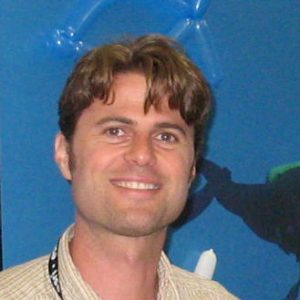Human use of the oceans is increasingly in conflict with conservation of endangered species. Evaluation of environmental impacts have historically been post hoc; the time and place of human activity is often already proposed before assessment. I describe anticipatory spatial decision support frameworks that highlight tradeoffs between industry and conservation with interactively synchronized map and tradeoff plots for two spatially distinct problems: siting for offshore wind energy development (OWED) and routing for ships to avoid striking whales.
Offshore wind energy development suffers from a lengthy environmental compliance process, estimated to incur a 7 to 10 year permitting timeline in the US. To responsibly and expeditiously evaluate environmental impacts we differentially assess sensitivity of wildlife above the water line in space, and below the water line in time. During long-term OWED operation, birds can collide and be displaced by active turbines. During episodic pre-operation phases, cetaceans are most heavily impacted acoustically by seismic airgun surveys and pile driving. The framework highlights sites in space that are most profitable and least sensitive to birds. For a given site, pre-operation activities are advised by cetacean sensitivity across months of the year that minimize impacts on migratory cetaceans, particularly those of highest conservation concern such as the North Atlantic right whale (Eubalaena Glacialis) in the case of the US Mid-Atlantic study area.
For routing ships to avoid whale strikes, British Columbia is evaluated in light of potential new oil tanker traffic to Port Kitimat where an oil pipeline terminal is under consideration. Marine mammal species distributions are aggregated to a single map layer, weighted by species conservation concern. This map layer of risk to species acts as the resistance surface by which least-cost routing is implemented. Transformations are applied to this surface before the routing algorithm for providing a series of routes offering a range of tradeoffs between conservation and industry. Preemptive avoidance of whale hotspots by ships could theoretically become as commonplace in the oceans as traffic avoidance by cars with Google Maps.
The web-based interfaces are built using the open-source, cross-platform R package shiny. Future developments and broader applications will be discussed.
Ben Best is an environmental data scientist with a strong background in marine spatial ecology. He offers consulting services, current clients of which include the Ocean Health Index and Marine Biodiversity Observation Network. He has lectured at UCSB’s Bren School of Environmental Science & Management for several courses (GIS, Advanced GIS, Landscape Ecology, Environmental Informatics) as well as Duke University’s Nicholas School of the Environment (Marine GIS). He was previously employed as a senior analyst for the Ocean Health Index and research associate for development of the OBIS-SEAMAP marine animal observation geoportal. He recently completed a PhD at Duke University’s Nicholas School from the Marine Geospatial Ecology Lab and obtained an MS in Environmental Sciences from Duke, and from UCSB a BS in Aquatic Biology and BA in Geography.

Ben Best, Ph.D.
bbest@nceas.ucsb.edu

